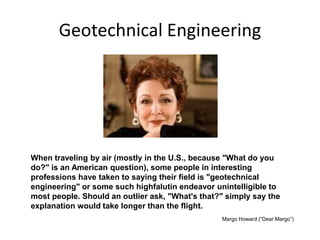The Main Principles Of Geotheta
The Main Principles Of Geotheta
Blog Article
Some Ideas on Geotheta You Should Know
Table of ContentsThe Basic Principles Of Geotheta The Basic Principles Of Geotheta Getting My Geotheta To WorkGetting My Geotheta To WorkThings about Geotheta

They carry out website investigations, gather examples, carry out lab examinations, and examine information to assess the viability of the ground for building and construction tasks - Engineer of Record. Based on their findings, geotechnical designers provide suggestions for foundation layout, slope security, retaining frameworks, and mitigation of geotechnical dangers. They team up with various other experts, such as engineers, structural designers, and building teams, to ensure that geotechnical considerations are incorporated right into the general project layout and execution
By evaluating the actions and properties of dirt and rock, they can determine potential geotechnical hazards such as landslides, soil settlement, or incline instability. Their proficiency aids protect against failings or mishaps that could jeopardize lives and home. Below are some comprehensive tasks and duties of a geotechnical designer: Website Investigation: Geotechnical designers conduct site examinations to collect data on subsurface problems.
They interpret the data to understand the buildings and actions of the dirt and rock, including their stamina, leaks in the structure, compaction attributes, and groundwater conditions. Geotechnical Analysis and Style: Geotechnical designers examine the information gathered during website investigations to assess the stability and viability of the website for building and construction jobs. They perform geotechnical estimations and modeling to evaluate variables such as birthing capability, negotiation, slope stability, side planet pressures, and groundwater circulation.
Geotheta for Dummies
Structure Style: Geotechnical designers play a crucial role in creating structures that can securely sustain the intended structure. They assess the dirt problems and load needs to determine the ideal foundation kind, such as shallow foundations (e.g., footings), deep structures (e.g (http://peterjackson.mee.nu/do_you_ever_have_a_dream#c2153)., heaps), or specialized techniques like dirt improvement. They consider aspects such as negotiation limits, bearing capacity, and soil-structure communication to establish optimal structure styles
They review building and construction plans, monitor site tasks, and perform area assessments to verify that the design recommendations are followed. If unexpected geotechnical problems emerge, they examine the situation and offer suggestions for remediation or changes to the layout. Danger Evaluation and Mitigation: Geotechnical designers assess geotechnical risks and risks connected with the project website, such as landslides, liquefaction, or dirt disintegration.

Cooperation and Interaction: Geotechnical designers work carefully with other professionals entailed in a task, such as designers, architectural designers, and building groups. Effective interaction and cooperation are important to incorporate geotechnical considerations into the total job layout and building procedure. Geotechnical engineers offer technical expertise, solution queries, and ensure that geotechnical demands are met.
The Ultimate Guide To Geotheta
Below are some kinds of geotechnical engineers: Foundation Engineer: Foundation engineers specialize in creating and analyzing foundations for structures. They assess the soil problems, load needs, and site characteristics to figure out one of the most appropriate structure kind and layout, such as superficial structures, deep foundations, or specialized techniques like heap foundations.
They assess the aspects influencing incline stability, such as soil residential properties, groundwater problems, and slope geometry, and develop approaches to stop slope failings and mitigate risks. Earthquake Designer: Earthquake designers specialize in examining and making structures to stand up to seismic forces. They analyze the seismic danger of a website, assess soil liquefaction capacity, and create seismic layout requirements to ensure the security and durability of structures during quakes.
They perform field testing, accumulate samples, and assess the accumulated information to define the soil buildings, geologic formations, and groundwater problems at a site. Geotechnical Instrumentation Engineer: Geotechnical instrumentation designers concentrate on surveillance and gauging the behavior of dirt, rock, and structures. They install and keep instrumentation systems that keep track of aspects such as dirt negotiation, groundwater levels, incline activities, and structural displacements to evaluate performance and provide very early warnings of potential concerns.
Our Geotheta Diaries
They carry out examinations such as triaxial examinations, debt consolidation examinations, straight shear tests, and leaks in the structure tests to collect data for geotechnical evaluation and layout. Geosynthetics Engineer: Geosynthetics designers focus on the style and application of geosynthetic products, such as geotextiles, geogrids, and geomembranes. They use these products to enhance soil stability, strengthen inclines, supply water drainage remedies, and control erosion.
They tend to be investigative people, which implies they're intellectual, reflective, and analytical. They are curious, systematic, sensible, logical, and rational. Some of them are likewise social, meaning they're kind, generous, participating, person, caring, practical, understanding, sensible, and pleasant - Geo Tech Engineer.
In the workplace environment, geotechnical designers utilize specialized software devices to do calculations, develop designs, and evaluate information. They prepare reports, testimonial job requirements, connect with customers and staff member, and coordinate job tasks. The office setup provides a conducive atmosphere for research, evaluation, and partnership with other professionals associated with the job.
The Best Guide To Geotheta
They often go to project sites to conduct website examinations, analyze geotechnical conditions, and collect information for view website evaluation. These visits include traveling to various areas, often in remote or difficult surfaces. Geotechnical engineers might carry out soil sampling, conduct tests, and monitor building tasks to ensure that the geotechnical facets of the job are being implemented properly.
Geotechnical engineers likewise operate in specialized geotechnical laboratories. In these facilities, they perform experiments, perform examinations on dirt and rock examples, and analyze the design buildings of the materials. Geotechnical lab engineers work thoroughly in these settings, dealing with testing tools, operating tools, and videotaping data. They collaborate with various other research laboratory personnel to ensure precise and trustworthy testing outcomes.
Report this page